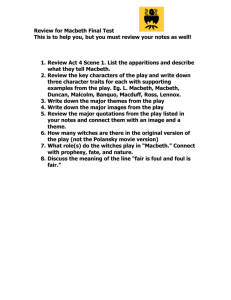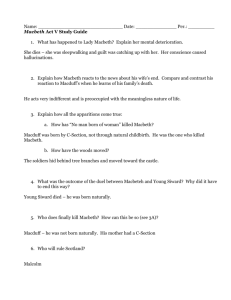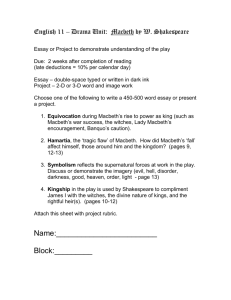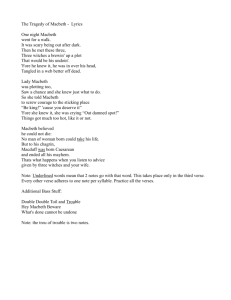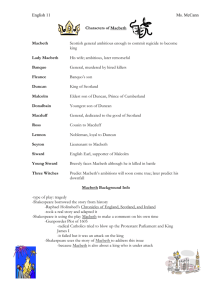Macbeth - billkadar.us
advertisement
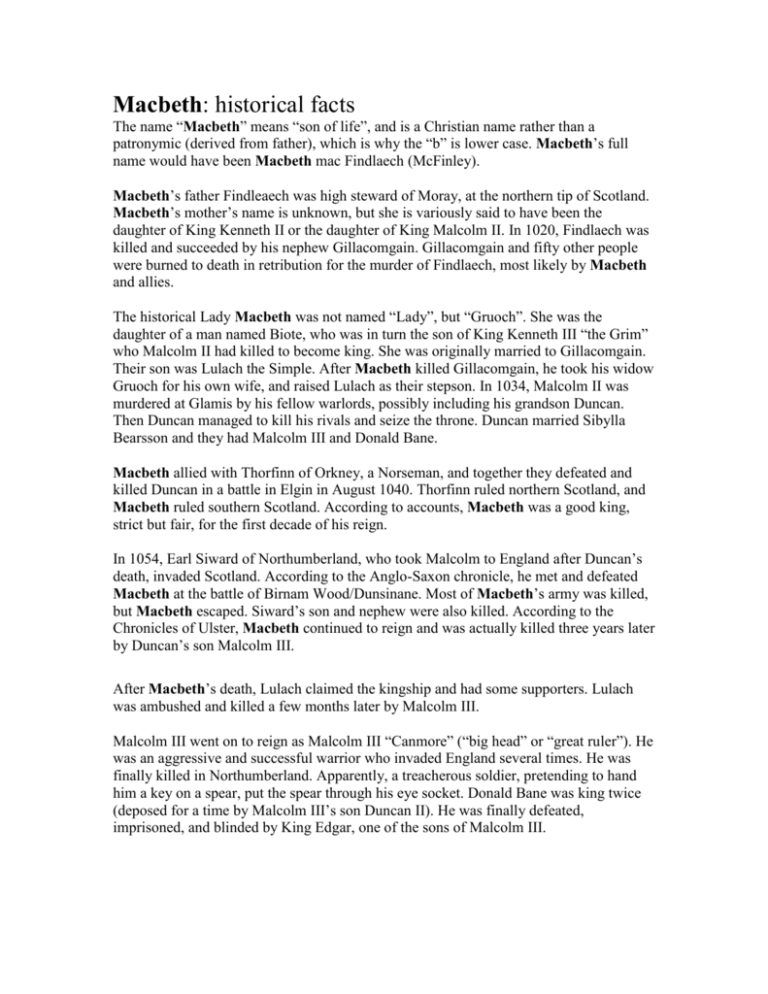
Macbeth: historical facts The name “Macbeth” means “son of life”, and is a Christian name rather than a patronymic (derived from father), which is why the “b” is lower case. Macbeth’s full name would have been Macbeth mac Findlaech (McFinley). Macbeth’s father Findleaech was high steward of Moray, at the northern tip of Scotland. Macbeth’s mother’s name is unknown, but she is variously said to have been the daughter of King Kenneth II or the daughter of King Malcolm II. In 1020, Findlaech was killed and succeeded by his nephew Gillacomgain. Gillacomgain and fifty other people were burned to death in retribution for the murder of Findlaech, most likely by Macbeth and allies. The historical Lady Macbeth was not named “Lady”, but “Gruoch”. She was the daughter of a man named Biote, who was in turn the son of King Kenneth III “the Grim” who Malcolm II had killed to become king. She was originally married to Gillacomgain. Their son was Lulach the Simple. After Macbeth killed Gillacomgain, he took his widow Gruoch for his own wife, and raised Lulach as their stepson. In 1034, Malcolm II was murdered at Glamis by his fellow warlords, possibly including his grandson Duncan. Then Duncan managed to kill his rivals and seize the throne. Duncan married Sibylla Bearsson and they had Malcolm III and Donald Bane. Macbeth allied with Thorfinn of Orkney, a Norseman, and together they defeated and killed Duncan in a battle in Elgin in August 1040. Thorfinn ruled northern Scotland, and Macbeth ruled southern Scotland. According to accounts, Macbeth was a good king, strict but fair, for the first decade of his reign. In 1054, Earl Siward of Northumberland, who took Malcolm to England after Duncan’s death, invaded Scotland. According to the Anglo-Saxon chronicle, he met and defeated Macbeth at the battle of Birnam Wood/Dunsinane. Most of Macbeth’s army was killed, but Macbeth escaped. Siward’s son and nephew were also killed. According to the Chronicles of Ulster, Macbeth continued to reign and was actually killed three years later by Duncan’s son Malcolm III. After Macbeth’s death, Lulach claimed the kingship and had some supporters. Lulach was ambushed and killed a few months later by Malcolm III. Malcolm III went on to reign as Malcolm III “Canmore” (“big head” or “great ruler”). He was an aggressive and successful warrior who invaded England several times. He was finally killed in Northumberland. Apparently, a treacherous soldier, pretending to hand him a key on a spear, put the spear through his eye socket. Donald Bane was king twice (deposed for a time by Malcolm III’s son Duncan II). He was finally defeated, imprisoned, and blinded by King Edgar, one of the sons of Malcolm III. The play Macbeth was written specifically for King James I of England, who was also King James VI of Scotland, as a royal court performance. It was performed the summer of 1606 while the king’s brother-in-law King Christian of Denmark was visiting. Five of the characters with the play were real life ancestors of King James: Duncan Banquo old Siward Malcolm Fleance These characters perform no untoward acts within the play that may have made them seem unworthy of the royal family. King James was a genealogist and very passionate about his ancestors. Today, it is widely believed that Banquo and Fleance never existed, but in the early 17th century their names were still on Scotland’s royal family tree. James would have been familiar with them, whether they ever lived or not. James paternal grandfather, Matthew Stewart, had been Earl of Lennox, hence, the use of Lennox as a character name within the play. After the death of the historical Macbeth, Malcolm III made his thanes earls, specifically: Macduff Lennox Rosse Menteth Cathness Angus Old Siward was a Dane, known as “the great Dane, Siward the Strong”. He was a person well known to King James and his cousin King Christian. Historically, Siward was a supporter of the English king, Edward the Confessor and Malcolm III. Within the play, due to his historical connection to the king, he is pictured as an ideal soldier. The historical Macbeth never fought the Norwegians; he fought the Danes when they invaded Scotland in the 11th century. Because the play Macbeth was to be performed before the King of Denmark, the opposing force to the Scottish and the English was altered to the Norwegians. Because of his English connection, Malcolm III succeeded in Anglicizing England to some extent against the wishes of the Celts or Highland people. Donald Bane, on the other hand, fled to Ireland following Duncan’s death which was home of the Celts. When he succeeded his brother, he reacted to the Anglicization of Scotland by fighting against the English civilizing influence. In the play, Malcolm is to be admired for uniting two kingdoms, and Donalbain is to be discredited as an opponent of the unifying process. An historical side-note concerning the three witches In the first folio edition of William Shakespeare’s Macbeth, the witches were referred to as the “weyward” sisters, not the “weird” sisters. “Weyward” meant-perverse, forward, moody, obstinate, intractable-which were fit adjectives to describe the witches of Forres. In 1735, “weird” replaced “wayward” to better describe the witches as goddesses of destiny. “Weird” at this point in history meant “fate”. Some scholars believe that this change has altered interpretations of the witch’s role within the play. The witches in Macbeth are Scottish witches, not English witches. They are motivated by devilish malignity, tempting Macbeth but not controlling him. Shakespeare most likely did not intend for them to increase the fatalistic philosophies within the play that element of interpretation did not appear until their name was altered.
